Xiaoxiao Ma
MaskFocus: Focusing Policy Optimization on Critical Steps for Masked Image Generation
Dec 21, 2025Abstract:Reinforcement learning (RL) has demonstrated significant potential for post-training language models and autoregressive visual generative models, but adapting RL to masked generative models remains challenging. The core factor is that policy optimization requires accounting for the probability likelihood of each step due to its multi-step and iterative refinement process. This reliance on entire sampling trajectories introduces high computational cost, whereas natively optimizing random steps often yields suboptimal results. In this paper, we present MaskFocus, a novel RL framework that achieves effective policy optimization for masked generative models by focusing on critical steps. Specifically, we determine the step-level information gain by measuring the similarity between the intermediate images at each sampling step and the final generated image. Crucially, we leverage this to identify the most critical and valuable steps and execute focused policy optimization on them. Furthermore, we design a dynamic routing sampling mechanism based on entropy to encourage the model to explore more valuable masking strategies for samples with low entropy. Extensive experiments on multiple Text-to-Image benchmarks validate the effectiveness of our method.
Fast-ARDiff: An Entropy-informed Acceleration Framework for Continuous Space Autoregressive Generation
Dec 09, 2025Abstract:Autoregressive(AR)-diffusion hybrid paradigms combine AR's structured modeling with diffusion's photorealistic synthesis, yet suffer from high latency due to sequential AR generation and iterative denoising. In this work, we tackle this bottleneck and propose a unified AR-diffusion framework Fast-ARDiff that jointly optimizes both components, accelerating AR speculative decoding while simultaneously facilitating faster diffusion decoding. Specifically: (1) The entropy-informed speculative strategy encourages draft model to produce higher-entropy representations aligned with target model's entropy characteristics, mitigating entropy mismatch and high rejection rates caused by draft overconfidence. (2) For diffusion decoding, rather than treating it as an independent module, we integrate it into the same end-to-end framework using a dynamic scheduler that prioritizes AR optimization to guide the diffusion part in further steps. The diffusion part is optimized through a joint distillation framework combining trajectory and distribution matching, ensuring stable training and high-quality synthesis with extremely few steps. During inference, shallow feature entropy from AR module is used to pre-filter low-entropy drafts, avoiding redundant computation and improving latency. Fast-ARDiff achieves state-of-the-art acceleration across diverse models: on ImageNet 256$\times$256, TransDiff attains 4.3$\times$ lossless speedup, and NextStep-1 achieves 3$\times$ acceleration on text-conditioned generation. Code will be available at https://github.com/aSleepyTree/Fast-ARDiff.
Group Critical-token Policy Optimization for Autoregressive Image Generation
Sep 26, 2025Abstract:Recent studies have extended Reinforcement Learning with Verifiable Rewards (RLVR) to autoregressive (AR) visual generation and achieved promising progress. However, existing methods typically apply uniform optimization across all image tokens, while the varying contributions of different image tokens for RLVR's training remain unexplored. In fact, the key obstacle lies in how to identify more critical image tokens during AR generation and implement effective token-wise optimization for them. To tackle this challenge, we propose $\textbf{G}$roup $\textbf{C}$ritical-token $\textbf{P}$olicy $\textbf{O}$ptimization ($\textbf{GCPO}$), which facilitates effective policy optimization on critical tokens. We identify the critical tokens in RLVR-based AR generation from three perspectives, specifically: $\textbf{(1)}$ Causal dependency: early tokens fundamentally determine the later tokens and final image effect due to unidirectional dependency; $\textbf{(2)}$ Entropy-induced spatial structure: tokens with high entropy gradients correspond to image structure and bridges distinct visual regions; $\textbf{(3)}$ RLVR-focused token diversity: tokens with low visual similarity across a group of sampled images contribute to richer token-level diversity. For these identified critical tokens, we further introduce a dynamic token-wise advantage weight to encourage exploration, based on confidence divergence between the policy model and reference model. By leveraging 30\% of the image tokens, GCPO achieves better performance than GRPO with full tokens. Extensive experiments on multiple text-to-image benchmarks for both AR models and unified multimodal models demonstrate the effectiveness of GCPO for AR visual generation.
LLM-based Multi-Agent Copilot for Quantum Sensor
Aug 07, 2025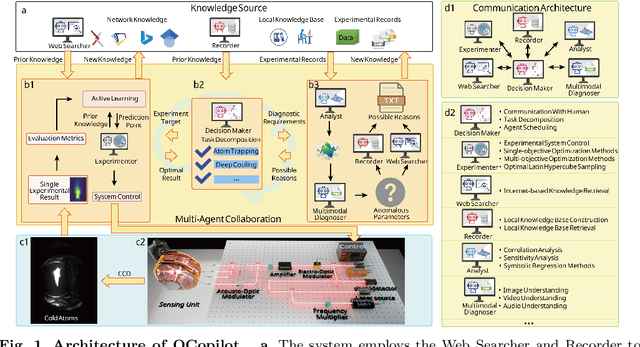
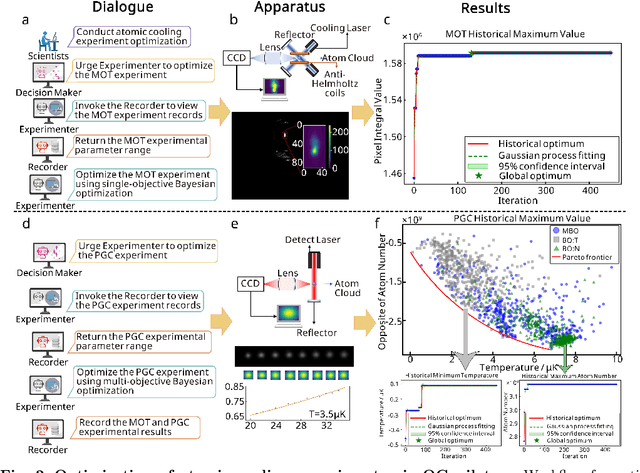
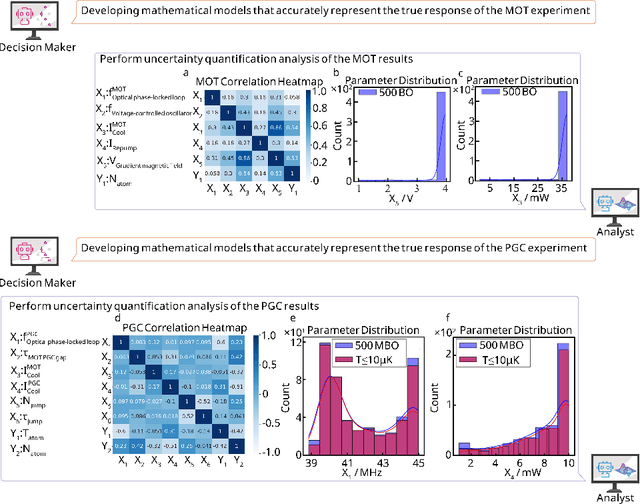
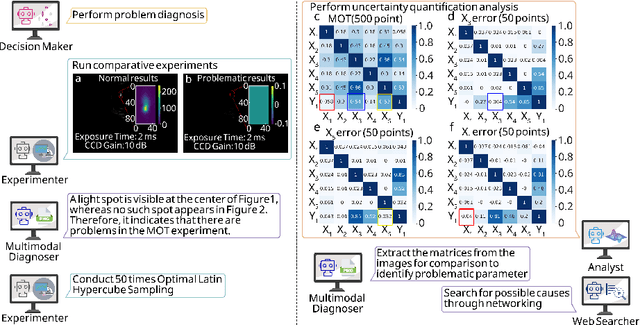
Abstract:Large language models (LLM) exhibit broad utility but face limitations in quantum sensor development, stemming from interdisciplinary knowledge barriers and involving complex optimization processes. Here we present QCopilot, an LLM-based multi-agent framework integrating external knowledge access, active learning, and uncertainty quantification for quantum sensor design and diagnosis. Comprising commercial LLMs with few-shot prompt engineering and vector knowledge base, QCopilot employs specialized agents to adaptively select optimization methods, automate modeling analysis, and independently perform problem diagnosis. Applying QCopilot to atom cooling experiments, we generated 10${}^{\rm{8}}$ sub-$\rm{\mu}$K atoms without any human intervention within a few hours, representing $\sim$100$\times$ speedup over manual experimentation. Notably, by continuously accumulating prior knowledge and enabling dynamic modeling, QCopilot can autonomously identify anomalous parameters in multi-parameter experimental settings. Our work reduces barriers to large-scale quantum sensor deployment and readily extends to other quantum information systems.
HQ-CLIP: Leveraging Large Vision-Language Models to Create High-Quality Image-Text Datasets and CLIP Models
Jul 30, 2025Abstract:Large-scale but noisy image-text pair data have paved the way for the success of Contrastive Language-Image Pretraining (CLIP). As the foundation vision encoder, CLIP in turn serves as the cornerstone for most large vision-language models (LVLMs). This interdependence naturally raises an interesting question: Can we reciprocally leverage LVLMs to enhance the quality of image-text pair data, thereby opening the possibility of a self-reinforcing cycle for continuous improvement? In this work, we take a significant step toward this vision by introducing an LVLM-driven data refinement pipeline. Our framework leverages LVLMs to process images and their raw alt-text, generating four complementary textual formulas: long positive descriptions, long negative descriptions, short positive tags, and short negative tags. Applying this pipeline to the curated DFN-Large dataset yields VLM-150M, a refined dataset enriched with multi-grained annotations. Based on this dataset, we further propose a training paradigm that extends conventional contrastive learning by incorporating negative descriptions and short tags as additional supervised signals. The resulting model, namely HQ-CLIP, demonstrates remarkable improvements across diverse benchmarks. Within a comparable training data scale, our approach achieves state-of-the-art performance in zero-shot classification, cross-modal retrieval, and fine-grained visual understanding tasks. In retrieval benchmarks, HQ-CLIP even surpasses standard CLIP models trained on the DFN-2B dataset, which contains 10$\times$ more training data than ours. All code, data, and models are available at https://zxwei.site/hqclip.
Enhanced Small Target Detection via Multi-Modal Fusion and Attention Mechanisms: A YOLOv5 Approach
Apr 15, 2025Abstract:With the rapid development of information technology, modern warfare increasingly relies on intelligence, making small target detection critical in military applications. The growing demand for efficient, real-time detection has created challenges in identifying small targets in complex environments due to interference. To address this, we propose a small target detection method based on multi-modal image fusion and attention mechanisms. This method leverages YOLOv5, integrating infrared and visible light data along with a convolutional attention module to enhance detection performance. The process begins with multi-modal dataset registration using feature point matching, ensuring accurate network training. By combining infrared and visible light features with attention mechanisms, the model improves detection accuracy and robustness. Experimental results on anti-UAV and Visdrone datasets demonstrate the effectiveness and practicality of our approach, achieving superior detection results for small and dim targets.
Stance-Driven Multimodal Controlled Statement Generation: New Dataset and Task
Apr 04, 2025



Abstract:Formulating statements that support diverse or controversial stances on specific topics is vital for platforms that enable user expression, reshape political discourse, and drive social critique and information dissemination. With the rise of Large Language Models (LLMs), controllable text generation towards specific stances has become a promising research area with applications in shaping public opinion and commercial marketing. However, current datasets often focus solely on pure texts, lacking multimodal content and effective context, particularly in the context of stance detection. In this paper, we formally define and study the new problem of stance-driven controllable content generation for tweets with text and images, where given a multimodal post (text and image/video), a model generates a stance-controlled response. To this end, we create the Multimodal Stance Generation Dataset (StanceGen2024), the first resource explicitly designed for multimodal stance-controllable text generation in political discourse. It includes posts and user comments from the 2024 U.S. presidential election, featuring text, images, videos, and stance annotations to explore how multimodal political content shapes stance expression. Furthermore, we propose a Stance-Driven Multimodal Generation (SDMG) framework that integrates weighted fusion of multimodal features and stance guidance to improve semantic consistency and stance control. We release the dataset and code (https://anonymous.4open.science/r/StanceGen-BE9D) for public use and further research.
STAR: Scale-wise Text-to-image generation via Auto-Regressive representations
Jun 16, 2024
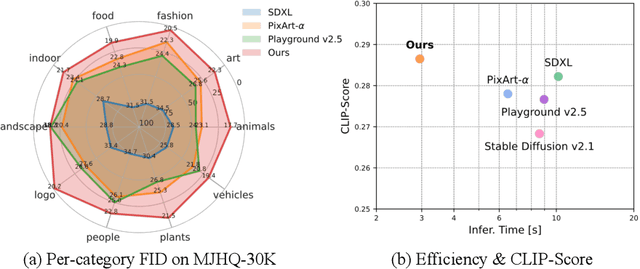
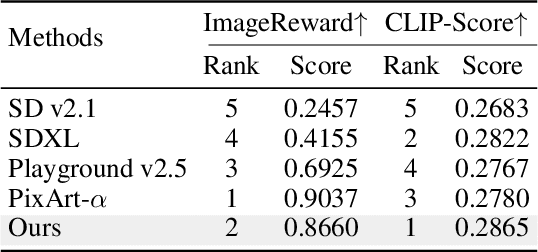
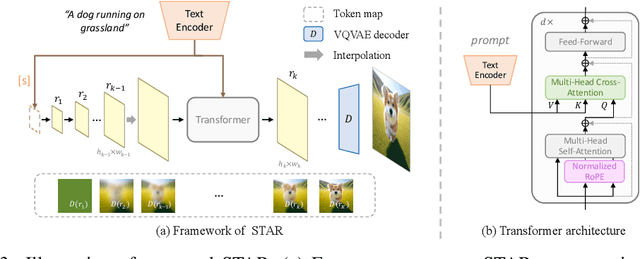
Abstract:We present STAR, a text-to-image model that employs scale-wise auto-regressive paradigm. Unlike VAR, which is limited to class-conditioned synthesis within a fixed set of predetermined categories, our STAR enables text-driven open-set generation through three key designs: To boost diversity and generalizability with unseen combinations of objects and concepts, we introduce a pre-trained text encoder to extract representations for textual constraints, which we then use as guidance. To improve the interactions between generated images and fine-grained textual guidance, making results more controllable, additional cross-attention layers are incorporated at each scale. Given the natural structure correlation across different scales, we leverage 2D Rotary Positional Encoding (RoPE) and tweak it into a normalized version. This ensures consistent interpretation of relative positions across token maps at different scales and stabilizes the training process. Extensive experiments demonstrate that STAR surpasses existing benchmarks in terms of fidelity,image text consistency, and aesthetic quality. Our findings emphasize the potential of auto-regressive methods in the field of high-quality image synthesis, offering promising new directions for the T2I field currently dominated by diffusion methods.
Heterogeneous Subgraph Transformer for Fake News Detection
Apr 19, 2024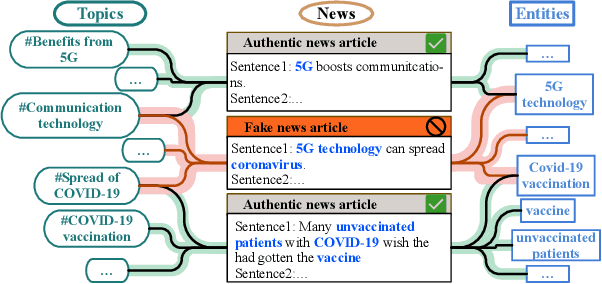



Abstract:Fake news is pervasive on social media, inflicting substantial harm on public discourse and societal well-being. We investigate the explicit structural information and textual features of news pieces by constructing a heterogeneous graph concerning the relations among news topics, entities, and content. Through our study, we reveal that fake news can be effectively detected in terms of the atypical heterogeneous subgraphs centered on them, which encapsulate the essential semantics and intricate relations between news elements. However, suffering from the heterogeneity, exploring such heterogeneous subgraphs remains an open problem. To bridge the gap, this work proposes a heterogeneous subgraph transformer (HeteroSGT) to exploit subgraphs in our constructed heterogeneous graph. In HeteroSGT, we first employ a pre-trained language model to derive both word-level and sentence-level semantics. Then the random walk with restart (RWR) is applied to extract subgraphs centered on each news, which are further fed to our proposed subgraph Transformer to quantify the authenticity. Extensive experiments on five real-world datasets demonstrate the superior performance of HeteroSGT over five baselines. Further case and ablation studies validate our motivation and demonstrate that performance improvement stems from our specially designed components.
Seed Optimization with Frozen Generator for Superior Zero-shot Low-light Enhancement
Feb 15, 2024



Abstract:In this work, we observe that the generators, which are pre-trained on massive natural images, inherently hold the promising potential for superior low-light image enhancement against varying scenarios.Specifically, we embed a pre-trained generator to Retinex model to produce reflectance maps with enhanced detail and vividness, thereby recovering features degraded by low-light conditions.Taking one step further, we introduce a novel optimization strategy, which backpropagates the gradients to the input seeds rather than the parameters of the low-light enhancement model, thus intactly retaining the generative knowledge learned from natural images and achieving faster convergence speed. Benefiting from the pre-trained knowledge and seed-optimization strategy, the low-light enhancement model can significantly regularize the realness and fidelity of the enhanced result, thus rapidly generating high-quality images without training on any low-light dataset. Extensive experiments on various benchmarks demonstrate the superiority of the proposed method over numerous state-of-the-art methods qualitatively and quantitatively.
 Add to Chrome
Add to Chrome Add to Firefox
Add to Firefox Add to Edge
Add to Edge